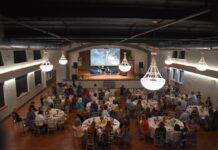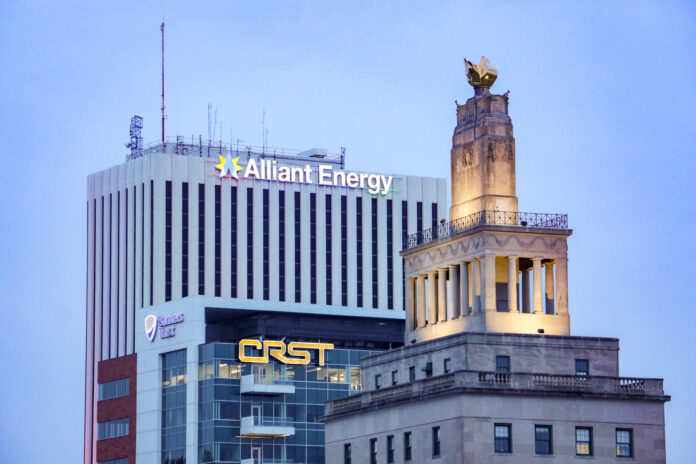
This is the second article of a two-part series examining the landscape of downtown Cedar Rapids. Part 1 was published Feb. 24 and can be found by clicking here. It might be surprising to learn that visitor traffic to downtown Cedar Rapids has rebounded to near pre-pandemic levels. It’s just one of the key metrics identified by Downtown CR […]
Want to Read More?
Get immediate, unlimited access to all subscriber content and much more.
Learn more in our subscriber FAQ.
- Unparalleled business coverage of the Iowa City / Cedar Rapids corridor.
- Immediate access to subscriber-only content on our website.
- 26 issues per year delivered digitally, in print or both.
- Support locally owned and operated journalism.
Do you want to read and share this article without a paywall?
Click here to purchase a paywall bypass linkThis is the second article of a two-part series examining the landscape of downtown Cedar Rapids. Part 1 was published Feb. 24 and can be found by clicking here.
It might be surprising to learn that visitor traffic to downtown Cedar Rapids has rebounded to near pre-pandemic levels.
It’s just one of the key metrics identified by Downtown CR as part of charting a new future for downtown – an area that’s faced a series of challenges in recent years, but has countered those challenges with dramatic progress in entertainment, housing and nightlife opportunities.
And it’s all guided by the Downtown Vision and Action Plan – the so-called “North Star” of Downtown CR’s mission.
“If someone’s got a question of ‘why are we doing this?’ I can point them right to the page on the Vision Plan and say, ‘this is why,’” said Downtown CR executive director Caleb Knutson. “Everything we do goes back to that.”
For Downtown CR program manager Jennifar Bassett, the Vision and Action Plan provided a definitive “road map” as she developed and explored her new position.
“How many times has someone gone into a new role, and you’re not really quite sure what your role is?” she said. “Having a map that’s laid out for you is amazing. It’s right there.”
Downtown Vision Plan specifics
The latest comprehensive version of the Downtown Vision and Action Plan, adopted by the Cedar Rapids City Council in December 2023, envisions a rejuvenated mixed-use city core with evolving recreational and entertainment opportunities, a renewed focus on embracing the Cedar River and improved connectivity with adjacent districts and neighborhoods.
The detailed plan is designed to guide the growth and development of downtown Cedar Rapids over the next five years.
It summarizes a trio of overarching goals:
• Embrace the Cedar River – A top community priority will create an activated downtown waterfront by incorporating the Cedar River into the built environment. Second Avenue could be converted into a curb-less festival street in the short term, which could be closed temporarily for festivals and other events, and a linear park in the longer term. An activated Mays Island would incorporate a public plaza and flexible lawn area, a boardwalk and fishing area, and a picnic and beach area.
• Ensure an activated and vibrant downtown area – A clean, safe and welcoming downtown area would regularly draw visitors from across the city, in part by converting Third Street SE to a “festival street” and rerouting the Cedar Valley Nature Trail to connect with Third Street. Regular programming in downtown public spaces would also be offered, with public art and other physical enhancements, and retaining downtown jobs would become a focal effort. A broader range of social options, including the potential for riverside dining venues, would also improve the area’s cross-generational appeal.
• Improve connectivity within downtown and to adjacent districts and neighborhoods – Creating a more consistent and cohesive urban experience would include improvements in accessibility, improving physical connections to neighboring districts, enhancing the downtown parking experience, providing more outdoor recreation opportunities and improving wayfaring signage. A catalytic project would build on ConnectCR by expanding the Cedar Valley Nature Trail to incorporate the railroad crossing between Quaker Oats and Cargill.
The plan also includes an extensive implementation framework, determining an advisory timeline for nearly 70 certain goals and strategies as well as recommendations for a lead organization for pursuing each initiative, “most of which will be piloted by the City of Cedar Rapids, the SSMID, and/or the Cedar Rapids Metro Economic Alliance,” the plan indicates. “Many initiatives also require support from other civic partners that include public, private, and non-profit organizations in the Cedar Rapids region.”
Ms. Bassett noted that the Vision Plan was heavily influenced by community input and feedback.
“There were community surveys, and the community was asked what they wanted,” she said. “That comes back to that servant leadership, serving the community, but also staying in line with what has been laid out for us through that vision plan.”
Mr. Knutson also noted that the plan is intended to be referenced regularly, as opposed to another report filed away for hypothetical future use.
“You’re always developing plans, but you don’t want them to sit on the shelf and collect dust,” he said. “This is a living, breathing document. So when people come to us, when things are suggested, it’s a matter of, does this make sense for the Vision Plan? Yes or no? It could be activation. It could be working with the city on different initiatives, working with Parks and Recreation. There’s not a day that I’ve been here where we haven’t talked about the Vision Plan.”
An implementation team of several key downtown stakeholders meets monthly to assess progress on the Vision Plan’s goals.
“We’re sitting together, going through a Google spreadsheet, saying ‘this is what was accomplished in ‘24, this is what we’re working on ‘25,’” Mr. Knutson said. “And it’s not just ‘this is what we’re doing.’ It’s ‘are we on target?’”
A series of updates to the plan were announced in late January, including:
• The relocation of the Tree of 5 Seasons, with work now ongoing on the surrounding Five Seasons Plaza.
• Construction of Riverfront Park this fall as part of the city’s Greenway Parks project.
• Improvements to Mays Island that include tree planting this spring; the streamlining of planters along the Third Avenue Bridge bike lane; and a Bloomberg grant application for asphalt art on the Second Avenue bridge to increase pedestrian safety.
• The completion of a Music Census of area musicians (results were released in late February).
• The expansion of Five Seasons Lights to enhance visitor experience.
• Completion of a Lodging Study to attract additional hotels to downtown.
READ THE FULL VISION PLAN:
Changing perceptions of downtown
Known as a retail and business hub as recently as the 1980s, current efforts to reinvent downtown Cedar Rapids are increasingly focused on housing, dining and entertainment options.
Mr. Knutson, who came to his new role with Downtown CR in October, said Cedar Rapids has become well-known for its “phenomenal” bar food, a trait that has helped characterize its ongoing evolution.
And as a downtown resident himself, he said the area is developing an emerging vibrancy that’s establishing differentiation from its past identity.
“The city has changed,” he said. “I have heard this was a tech hub back in the day, a lot of businesses. But now, when you look at downtown, we’ve got so many great venues, so many different great restaurants. It’s really becoming an entertainment district. We can’t keep looking to the past. You can say, ‘I wish we still had X, Y and Z here,’ but that doesn’t exist anymore. What we do have is an incredibly thriving downtown.”
Those perceptions are being borne out through statistics. According to Placer.ai analytics, downtown Cedar Rapids recorded a total of 4.9 million visits in 2024, a near-complete return to the 5.1 million visits recorded in 2018.

The number of visitors during that same period rose from 746,000 in 2018 to 753,000 in 2024, indicating the downtown area has experienced a near-complete recovery in visitor traffic since the COVID-19 pandemic.
Ms. Bassett said downtown Cedar Rapids is increasingly becoming a lively social scene, with newer venues like Kingston Yard’s Pickle Palace and Big Grove Brewery, along with the McGrath Amphitheatre, joining legacy venues like the Paramount Theatre and Theatre Cedar Rapids to provide options for an ever-widening demographic. And, of course, a new Cedar Crossing Casino is set to join the scene in late 2026.
“We’re really becoming an entertainment hub,” she said. “And there’s a lot coming to downtown Cedar Rapids. There’s another hotel that we really need. There’s some businesses that are relocating to downtown. With restaurants, maybe one closes, but then one or two more pop open. And we’re diversifying that too, not just in terms of places to go, but also ownership of these establishments being a more diverse crowd. When you have that, that brings different demographics that you wouldn’t have normally had. So we’re really tapping into that.”
She said the area is evolving toward what she called a “retail-tainment” district, with live venues combined with an ever-broadening culinary scene.
“We’re exploring the idea of being social and interactive at the same time,” she said. “It’s like what Marvel does. When they release a new movie, they have these pop-ups where you can go and stick your hand inside of Iron Man and move it around, or you can go to a screen and touch it. That’s what kids do. It’s interactive and immersive. Bringing more of that, having Cedar Rapids stand out, as no one else is doing that in Iowa – the competitive side of me really likes that. I want us to do it bigger and better and more efficiently, in the best way possible.”
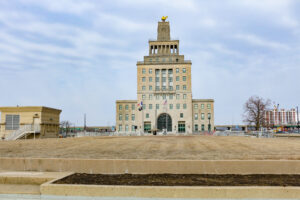
Mr. Knutson said he advised his son during a recent visit to downtown Cedar Rapids that the area might be a little loud at night.
“We got up the next morning, and he’s like ‘oh yeah, dad, man, it was loud,’” Mr. Knutson said. “That’s because there are people out going to events, they’re parking their cars, they’re walking to the Powerhouse, they’re walking to TCR, they’re walking to the Paramount, they’re walking to all the fantastic bars and restaurants we have downtown. They’re having a good time and enjoying themselves. And I don’t know that there’s a lot of cities in the country, let alone Iowa, that can say that they’re back to pre-pandemic numbers for visitors. That’s a great anchor for us. These downtown bars and restaurants – they’re fantastic, and they’re packed on the weekends. We’re just making sure that we’re telling that story, that we’re doing well in Cedar Rapids.”
“We’re bringing them to where we want them to be,” Ms. Bassett added. ”A bar and a restaurant is great. But what else can we offer?”
To that end, Downtown CR has announced a series of 2025 priorities for downtown development, including activating the iconic Mays Island to encourage engagement and visitation, relaunching the “Race for the Space” initiative to encourage businesses to consider relocating to the downtown area, launching a second test run of the downtown trolley this summer to further improve connectivity with the NewBo District and Czech Village, and expanding the area’s live entertainment and programming options. (For more, click here.)
Overcoming parking challenges
One of the most common objections to visiting any downtown area, including Cedar Rapids, concerns parking challenges, from hourly costs to limited parking times to paying for parking through a mobile app.
Mr. Knutson said a parking study is being conducted to assess the downtown area’s parking needs and operations, but he also noted that downtown Cedar Rapids has better walkability, and easier access to parking options, than many other mid-sized cities.
“People are always going to complain about parking,” he said.
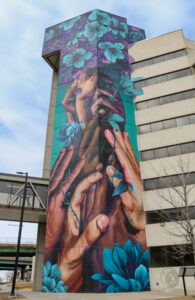
Regarding Park CR’s parking apps, which have largely replaced on-street parking meters with an online payment system based on parking zones and vehicle license plates, Mr. Knutson said concerns about the process are largely a “generational difference.”
“We’re figuring out how we can bridge that generation gap,” he said. “People might not be comfortable using the app, but are there other ways we can do that?”
Ms. Bassett said the parking study is taking downtown changes into consideration.
She also noted that Downtown CR was able to help a downtown restaurant address patrons’ concerns about parking challenges through a customer-facing, restaurant-specific QR code created by Park CR, the agency that operates the city’s parking system.
Once a customer scans the QR code, any parking fees they incur are paid by the restaurant via the customer’s meal tab.
“They (the customer) don’t have to deal with it,” she said. “(The owner) wanted to be able to take care of the parking for his customers, so we created the QR code.”
She also noted she recently learned that if a new business brings jobs downtown, they are eligible for a 50% discount for their employees’ parking fees.
“I’m sure a lot of people don’t know that,” she said. “It’s just talking to people and seeing what they want and how it can be incorporated into this asset. We already have a great asset. Let’s use what we have to our advantage.”
Addressing downtown’s challenges
Downtown Cedar Rapids is certainly not without its challenges, from a significant decline in downtown business employment to unhoused residents and touted development projects that have failed to materialize.
But Downtown CR is working to deal with those challenges.
According to Mr. Knutson, downtown Cedar Rapids saw a 35% decrease in its homeless population in 2024, and Downtown CR continues to work on homelessness issues with J’Nae Peterman, homeless systems manager for the East Central Iowa Council of Governments.
Several efforts are under way to reduce homelessness in Cedar Rapids, including funding for a Lived Experience Council, the creation of a Local Oversight Board, and the launch of a Landlord and Tenant Success pilot program.
Meanwhile, other cities in the state are reporting increased homelessness numbers, Mr. Knutson said.
“When you add bars and restaurants and housing and work changes, and people lose their jobs, you’re going to have a higher unemployment rate, and you’re going to have a higher unhoused rate,” Ms. Bassett said. “Those are some of the things that maybe weren’t thought about. So now there’s a lot of different organizations and people trying to work together to bring that around and make it better.”
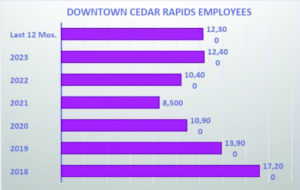
Meanwhile, the number of people working downtown has been declining for several years. As of 2024, 12,300 people were reported to be working at a downtown location, down from 17,200 in 2018. Downtown Cedar Rapids hosts just 72% of the workforce it hosted in 2018.
It’s an issue that will continue to impact the downtown district, and Ms. Bassett said a number of factors are at play, from a lack of child care options to the rise of hybrid work since the COVID-19 pandemic.
“It’s a matter of maneuvering that, because you can’t really change it,” she said. “It’s so complex. We just need to figure out a different way.”
While incentives can improve the situation in some cases, Mr. Knutson said the choice remains with business owners regarding their physical space requirements.
“We’re not in a place to go into these businesses and say, you need to have your people back to work,” he said. “We are not downtown HR. We can’t do that. And hybrid (work) has a place. Regardless of what anyone thinks of it, hybrid is here to stay.”
Housing options expanding, but more still needed
The development of housing options in downtown Cedar Rapids continues to be a high priority.
A Core District Housing Committee, led by city council member Scott Olson and developer Craig Byers, meets a few times each year to address housing challenges. The group includes developers, Realtors and general contractors.
At their most recent meeting, members reviewed progress on downtown housing development, highlighting the goal of building 3,000 new units.
So far, 1,000 units have been completed.
According to a 2022 study conducted by Maxfield Research and Consulting, downtown Cedar Rapids shows strong housing demand, with vacancy rates between 2% and 5%. However, financing challenges persist, and there is a need for low-income tax credits, the report shows.
Several new housing projects are in the works to fill the demand, comprising hundreds of new rental units. Among them, according to Mr. Knutson:
• A 63-unit building is 86% leased since April, with another 46-unit building and a hotel in development.
• A 183-unit project remains on schedule for completion in November 2025, featuring mixed-unit sizes and commercial space.
• A 31-unit upscale development in NewBo has already attracted young professionals, with nearly half leased.
• A 90-unit project is set to break ground this summer.
• Multiple completed and upcoming projects include 111 leased units, with an additional 52 under development.
• Another set of projects includes a fully leased 31-unit building, 72 planned units, and 13 market-rate residences.
• A 224-unit development is 63% occupied since March, with 60% designated for tax-credit renters.
Ms. Bassett said the development of downtown housing is encouraging, noting that if there had been more housing and amenities available downtown when she returned to Cedar Rapids, “I would have moved to downtown Cedar Rapids.”
“The challenge,” she said, “was that there were certain things that I was accustomed to, having lived in big cities, that downtown Cedar Rapids didn’t have. I love to just park my car and walk. I don’t think people understand the benefits to living in a place where it’s walkable. There are definite benefits to living downtown.”
Credit to board, policymakers
Mr. Knutson and Ms. Bassett use the word “collaboration” frequently to describe their work, crediting the efforts of Cedar Rapids community development director Jennifer Pratt, the city’s public works department, the VenuWorks team that operates the city’s major entertainment venues, and Park CR, among others.
But they saved their most effusive praise for members of the Downtown SSMID board of directors, particularly chairman James Klein and vice chairman Ted Kepros.
“Neither of us would be here without James Klein,” Mr. Knutson said. “He is so on fire and encouraging for downtown. He’ll send emails and messages saying ‘hey, check this out’ or ‘how are we doing on this, how’s this going?’ He’s just a great leader, because he’s really engaged, and he really cares about downtown.”
“Ted Kepros is the best hype man there is,” Ms. Bassett added. “He’s right there, in the background, just cheering us on.”
“It’s the exact type of leadership that you want as a chair and a vice chair,” Mr. Knutson added.
I could not ask for better leadership in my first 90 days here. We’re just so fortunate.”
Developing relationships with key stakeholders can be critical, Mr. Knutson said, especially when occasional differences arise.
“In talking to policymakers, it’s just creating that relationship,” he said. “When I meet a new policy maker, it’s an honest conversation – ‘hey, we both care about Cedar Rapids. We both want to see progress. We both want to see growth.’ There’s going to be a time where we disagree on something with different policymakers. And that doesn’t mean someone’s bad or someone’s wrong. It’s just that we have different perspectives, and if we can start the relationship from that foundation, we’ll be fine … there’s going to be conflict, but don’t walk away from the table when there’s conflict. That’s when you buckle up and say, ‘we’re going to get through this.’”
“We all want the same thing,” Ms. Bassett agreed. “It’s a conversation. How do we all get on the same page? We’re always making sure we’re doing what’s best for business, best for downtown, best for all parties involved. Some days are easier than others, but we’re all here for the same reason. We love downtown, we love Cedar Rapids. We want to see it thrive, and we want the community to want to come downtown and enjoy it when they do.
“Stay tuned,” she added. “We’re on the upswing. We’re doing this.”



